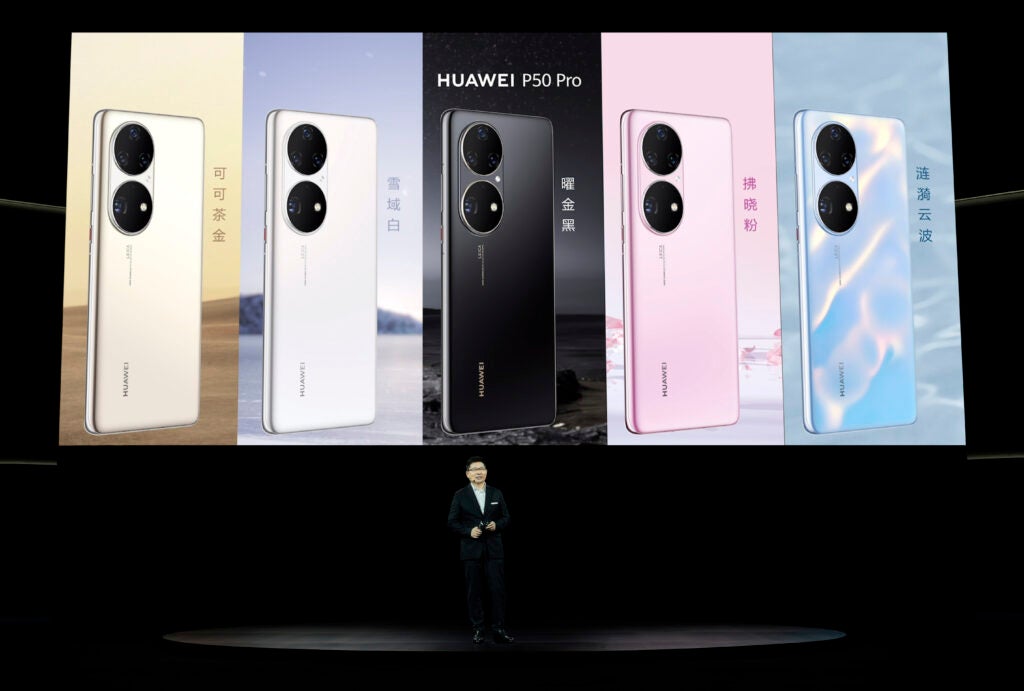
Huawei has unveiled two new flagship smartphones: the P50 and the P50 Pro. We’ve put the duo of handsets head-to-head to see what the big differences are.
In 2020, Huawei launched three P40 phones, the P40, P40 Pro and P40 Pro Plus. This time around, the Chinese tech giant has opted to release just two models – the base P50 and the more specced-out P50 Pro.
Keep reading to discover what the two phones have in common and why exactly Huawei is charging more for the Pro.
The P50 Pro has a bigger and faster display
One visual difference between the two smartphones lies in the size and speed of their displays.
The P50 includes a 6.5-inch OLED display that is flat like its predecessors, while the P50 Pro has an ever-so-slightly larger, curved 6.6-inch OLED display.
The P50 Pro also has a faster 120Hz refresh rate than the P50’s 90Hz refresh rate. While 90Hz is still above the basic 60Hz, allowing for smoother scrolling and gaming, the P50 Pro’s 120Hz refresh rate is even higher, offering an even smoother, more seamless experience.
Both phones benefit from a 300Hz touch sampling rate, 1400Hz high frame rate PWM dimming to help protect the eyes and HDR.
Because the P50 Pro’s screen is slightly bigger, the phone itself also has larger dimensions. The P50 Pro measures 158.8mm x 72.8mm x 8.5mm and weighs 195g, while the P50 measures 156.5mm x 73.8mm x 7.92mm and weighs 181g, making the P50 a little wider than the P50 Pro, but the Pro larger and heavier overall.

The P50 Pro has an additional camera
Both phones take advantage of Huawei’s Dual-Matrix Camera system, consisting of multiple lenses, a 10-channel multi-spectrum sensor, Huawei XD Optics to restore up to 25% of the image signal and the updated XD Fusion Pro Image Engine for better detail, colour and dynamic range.
Both phones also include a 13-megapixel wide angle front camera (f/2.4) and support for 4K video recording.
However, the P50 Pro has a quad camera array to the P50’s three sensors on its rear and the lenses on each differ slightly, too.
The P50 packs a 50-megapixel True-Chrome camera (f/1.8), a 13-megapixel ultra-wide angle camera (f/2.2) and a 12-megapixel telephoto camera (f/3.4) with OIS and AF support.
The P50 Pro features the same 50-megapixel True-Chrome camera (f/1.8) but with OIS, a 40-megapixel True-Chroma mono camera (f/1.6), a 13-megapixel ultra-wide angle camera (f/2.2) and a much bigger 64-megapixel telephoto camera (f/3.4) with OIS and AF support.
The main differences here are the addition of OIS to the main sensor, the True-Chrome mono camera and the larger telephoto camera all available on the Pro model.
The P50 Pro is available with more storage
While both models are powered by the same chipset, the Snapdragon 888 4G and the Adreno 660, the main difference in the phone’s specs lies in the configurations you can choose from.
The P50 is available with 8GB of RAM and 128/256GB of storage, while the P50 Pro can be bought with 8GB of RAM and 128/256/512GB of storage. There’s also a 12GB/512GB Pro model, but this is only available if you opt for the Pro or Pro Special Edition variants with Huawei’s own Kirin 9000 chip.

The P50 Pro has a bigger battery
The P50 Pro also includes a bigger battery than the standard P50.
The P50 is fitted with a 4100mAh battery, while the Pro takes advantage of a 4360mAh battery. This isn’t a huge leap, so it’s tough to determine at a glance whether the Pro model will actually benefit from a longer battery life here – especially as the higher-specced phone might require more power than its cheaper sibling. We’ll have to wait until we can test the phone ourselves to find out.
The P50 Pro also benefits from fast wireless charging. While both phones support Huawei’s Max 66W Wired SuperCharge, only the Pro is compatible with its Max 50W Wireless SuperCharge.
The P50 Pro is priced higher
Huawei has yet to release pricing information here in the UK, but it isn’t hard to assume the Pro model will cost more than the base P50.
Thankfully, Huawei has shared pricing for the Chinese market, so we can get a rough idea of how much the two phones might cost by converting those numbers to pounds.
The 8GB/128GB P50 has an RRP of ¥4488 (around £497), while the 8GB/256GB version is priced at ¥4988 (around £552). Meanwhile, the 8GB/128GB P50 Pro costs ¥5988 (around £663), the 8GB/256GB version costs ¥6488 (around £718) and the 8GB/512GB version ¥7488 (around £829).
There’s also a Special Edition P50 Pro model with 12GB/512GB at ¥8488 (around £940).
This leaves the 8GB/128GB P50 ¥1500 (around £166) than the 8GB/128GB P50 Pro, and the 8GB/256GB P50 also ¥1500 less than the 8GB/256GB Pro.
The post Huawei P50 vs P50 Pro: How do the two P50 series phones compare? appeared first on Trusted Reviews.
from Trusted Reviews https://ift.tt/3BXYXYr
via IFTTT



Comments
Post a Comment